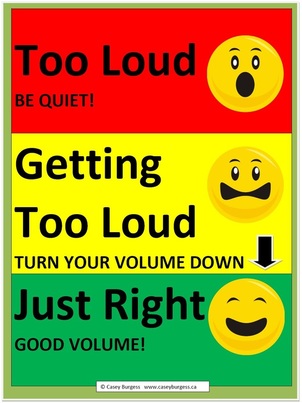When it is too noisy
This can be customised to include the relaxation techniques that work with your child. It can be placed on a child's desk as a reminder of how he can appropriately handle himself, or pointed to as a prompt when you think he needs a strategy to remain regulated.
Three Point Scale
This is an adaptation of the 5 point scale for children requiring something a little simpler. The chart part can be used to help teach a child what each colour means - green may mean calm, body feels relaxed, child feels happy....yellow may mean hands are clenching, shoulders are tight, and child feels nervous, and red may mean the shoulders are hunched, the jaw is clenched, the muscles all feel tight, and the child feels out of control. The idea is to prevent by teaching the child when they are escalating to yellow, giving them an easier way to tell you and to give them a nonverbal prompt to use their own relaxation tools to get themselves back to the green zone.
Volume Meter
Simply cut out the arrow and attach it to the chart with a butterfly clip, matching the circles. Use it as you would the volume meter to the right; indicate a child's volume to him or her, or use use it to prompt appropriate volume. Use a second arrow if you like, with one indicating the appropriate volume for the environment, and the other indicating the child's current volume. Reinforce the child's matching his/her volume to the appropriate volume.
|
Five Point Scale
This tool can be used in a number of ways. I've used it to teach children about their levels of escalation. For example, a 1 is very calm (sometimes we call it the green zone depending on the child). A 2 is a little anxious, 3 is upset, 4 is angry, and 5 is over the top. It's meant to be highly individualized, however. I might use this tool to teach a name for that group of feelings at each level, then later use it to ask a child how he is feeling, and even further, use it to show what to do to handle feelings and regulation at each level. For example, it's much easier for a child to respond that he is at a 2 than to explain, "well, my shoulders are feeling kind of tense and I'm not completely happy but I'm still under control...". Once a child learns, by us observing "you seem to be losing focus...I think you may be at a 2", what a two means, he can later respond, "I'm at a two", and we can prompt him to use a strategy that will relax him back down to a 1. See the work of Kari Dunn Buron on her Incredible 5-Point Scale for some fantastic ideas: www.http://www.5pointscale.com/
Volume Meter
This can be taped to a child's desk or used for the entire classroom. A paper clip can be attached to the side, and slid up and down to show the student or class, visually, when their volume is getting a little too much. It can also simply be pointed to as needed. I've even seen an actual stoplight used in some classrooms to get the same message across in a really fun way. Be creative! For students on the spectrum with sensory processing difficulties, sometimes they are simply unaware that their volume is greater than is expected in that environment. Rather than always verbally reminding, pointing to the appropriate section of the chart tells a student when he is regulating his volume well, when he needs to tone it down, and when he is over the top.
Transitions
Many children on the spectrum have difficulty with transitions. Part of this could be due to their difficulty with time concepts. We can use visuals to help them understand this concept a little better or at least accommodate for this difficulty. We can use small clock visuals as part of their visual schedules to show them the times that transitions will occur. When the clock on the wall matches their schedule, it's time to transition. We can also mark a 5 or 10 minute window on their schedule with red marker to show them that when the wall clock gets in this zone, a transition is coming soon. Within an activity, try using this clock visual to mark when the activity will end (again, you can include a red zone for the 5 minutes prior to it). Again, when the wall clock matches, it's time. You can even post the clock right beside the wall clock to make the connection clear.
|
More coming soon!

Stay tuned for more visual strategies, or let me know what you want to see!
Proudly powered by Weebly

